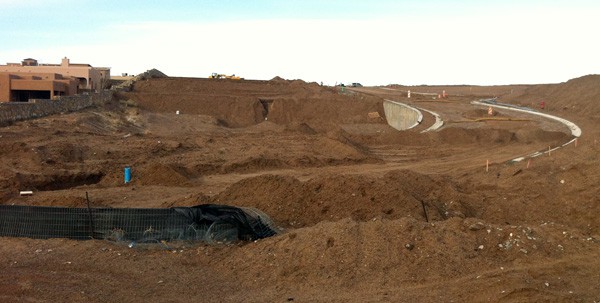
An area being developed on Las Cruces' north end. (Photo by Nick Voges)
We can all agree that “dust ordinance” is a silly name; that aside, don’t believe the hype. This ordinance isn’t “overly restrictive” or “punitive.” Protecting Las Crucens’ health and property is exactly the type of thing the city council should be working on.
We can all agree that it’s a silly name for an ordinance; especially since the “Wind Erosion Control Ordinance,” or the “dust” ordinance, as it is popularly called, would do so much to protect the health and the homes of many Las Crucens.
Unfortunately, as a result of the bad naming, coupled with the focused efforts of a few narrow business interests, the ordinance invites misinformed comments like this one from a Las Cruces marketing assistant, as quoted in a recent article by Steve Ramirez in the Las Cruces Sun News: “If you’re going to live in Las Cruces, or move here from somewhere else when you retire, it’s a no-brainer that you’re going to live in the desert, where there’s wind and dust a lot of the time. Yeah, it can get pretty nasty…”
Of course there’ll be dust in the desert, right? Any ordinances to eliminate dust from the desert surely exemplify government over-reach, right?

Nick Voges and his son Alton
That’s exactly the conclusion that, as quoted in the same article, Las Cruces Association of Realtors CEO Isaac Chavez reaches: “It would behoove the city council to stop passing overly restrictive, punitive ordinances that are making it harder and harder for the average Las Cruces family to afford a home of their own.”
But Mr. Chavez is wrong. This ordinance is not really about dust — it’s about protecting homeowners.
Protecting homeowners
Our friends, for example, live in a development off Porter and I-70 in Las Cruces. They bought a house there — their first home — about five years ago. It’s a charming house, cozy and practical, as a first home should be. When their house was built it was one of the first homes in the subdivision. During their first winter there they planned which flowers and trees they’d plant in their front yard to augment the landscaping that came with the house. Then the spring winds came. Everyone in New Mexico knows about our winds, but the Las Cruces varietal can be especially blustery.
One afternoon I stopped by their house to drop something off. My friend was out raking his front yard, trying desperately to get the dirt out of his gravel landscaping. Because theirs was one of the first houses in the subdivision, and the construction of new housing had slowed, their home was surrounded by block after block of empty, clear-cut lots. And so the spring wind dumped mounds of unsettled dirt onto the only thing out there: their landscaped front yard.
My friend is stalwart and stoic but you can only rake dirt out of your rocks so many times before you lose heart. These days, now that the dirt has covered over everything, they joke that their front yard is xeriscaped. Again, they’re not the type to complain, but they’ve lost thousands of dollars of value in their home. And it could have all been avoided if the developers had been good neighbors.
What should have been done?
The proposed revision to the ordinance outlines a number of precautions that responsible developers should take to protect homeowners who have built homes in their subdivisions. From the ordinance: “Dust and blowing dirt and sand shall be kept to a minimum by good practices such as using an approved dust suppressant or soil stabilizer, paving, covering, landscaping, continuous wetting, controlling access and speeds, or other acceptable means.”
Everyone knows that there will always be dust in the desert, but we also know that there are ways to make blowing dust, and its effect on the health and homes of the people who live here, better or worse. Here’s how the New Mexico Environmental Department puts it:
“While windblown dust naturally occurs in undisturbed areas throughout the west, it becomes much more common where the natural soils have been disturbed by anthropogenic activities. Natural soils have a tendency to form a mineral and organic crust that is resistant to erosion. Human activities can remove or break this crust, allowing dust to escape much more easily.”
This ordinance makes sure that developers take simple steps that protect the homeowners who have built homes in their subdivisions.
Health and Safety
The cost to homeowners isn’t the only problem that the ordinance addresses. According to this fact sheet, valley fever, which appears to be on the rise, is primarily caused by aspirating unsettled dust: “When the soil is disturbed by either the wind, construction, digging or driving on unpaved roads, the spores of the valley fever fungus are released into the air. Once in the air, the spores are inhaled as dust, and they begin growing and multiplying in your lungs.”
Valley fever is especially dangerous to vulnerable populations like infants and the elderly. Furthermore, since the big patches of unsettled dirt that carry valley fever now exist right next to more populated areas, more people are exposed to the dust that carries the valley fever fungus. The amount of dust in the air, and the chances that you’ll get valley fever, are greatly increased by the way that some developers now clear cut wide swathes of land. This could be mitigated if these developers would follow the simple protocols proposed by the ordinance to protect the health of all Las Crucens.
Not really about dust
Which leads us to the larger implicit question that Chavez raises: What is the proper role for our public institutions? To my mind, ordinances like this one, which came about because people’s health and homes are being ruined by the irresponsible actions of a few developers, are an example of how our public institutions can fulfill a key mission: promoting the common good. Everyone suffers when people are sick, and home values plummet as a result of a few bad actors. It’s essential that our public institutions institute and enforce the rules that protect citizens. Articles like Mr. Ramirez’s, by failing to report the full story about the ordinance and highlighting the comments of Isaac Chavez, only confuse the real aim of the ordinance.
In the end, although this ordinance concerns dust, it is actually about protecting homeowners and their investments, and the health and well-being of Las Crucens. Don’t believe Mr. Chavez’s hype; this ordinance isn’t, as he puts it, “overly restrictive” or “punitive.” Protecting Las Crucens’ health and property is exactly the type of thing the city council should be working on.
Nick Voges is the columnist behind NMPolitics.net’s Zeitgeist. E-mail him at nick@nmpolitics.net.
